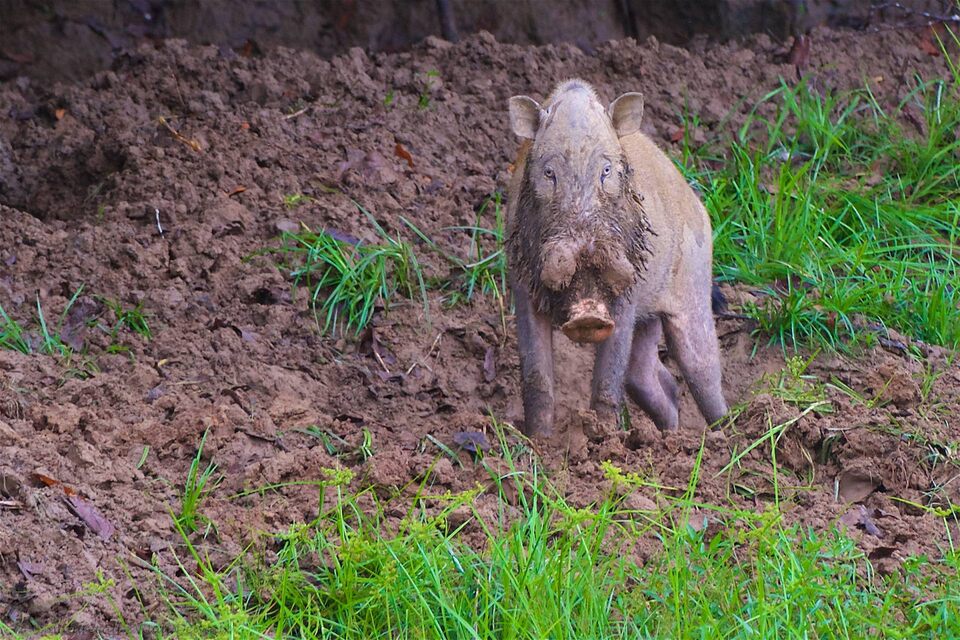Loss of Borneo’s great migration: Long-range satellite tracking of bearded pig (Sus barbatus) movements
About
PhD Researcher: David Kurz
Supervisors: Prof. Justin Brashares, Prof. Matthew Potts, Dr. Benoit Goossens
Veterinarian support: Dr Navaneetha Roopan, Wildlife Rescue Unit (SWD)
Institution: University of California – Berkeley
Status: Completed
The majority of large mammal migrations, the heartbeat of many ecological systems worldwide, are imperilled due to habitat loss and overhunting. The storied bearded pig migrations of Borneo’s rainforests may be unique among large mammals in their connection to rainforest fruiting cycles and are virtually unstudied despite evoking aweinspiring imagery on par with wildebeest thundering across the Serengeti or marine mammals coursing through oceans. Anecdotal accounts report bearded pig migrations characterised by thousands of pigs pulsing hundreds of kilometres through forests, across rivers, and up mountains to forage, yet the details of these movement patterns remain a great mystery. It is unclear whether the pigs’ migrations persist in increasingly fragmented landscapes and how these historical migrants may develop new foraging strategies given the abundance of year-round oil palm fruit available across large swaths of their range. Movement patterns of the pig in response to deforestation and oil palm expansion may hold major implications for the ecological dynamics of altered rainforest ecosystems and the development of the most appropriate management tools for preserving these systems.
Ecologically, the pig is thought to help structure tree communities through rooting, fruit and seed consumption, and sapling snapping. Thus, key bearded pig ecological functions – connected across spatial scales by migratory behaviour – are likely to be lost even before being fully understood. Culturally, archaeological evidence suggests the bearded pig has been Borneo’s indigenous peoples’ most important hunting target for at least 10,000 years, as it remains today. The bearded pig accounts for 5497% of wild meat consumed in nonMuslim rural areas of Borneo. Unfortunately, the extent to which wild pigs in the region are hunted (for subsistence as well as sport and commercial sale), coupled with extensive logging and deforestation, has created a crisis for bearded pig populations. Populations are estimated to have declined ~30% range-wide in the last two decades; as a result, the bearded pig (an IUCN-listed ‘Vulnerable’ species) is nearly extirpated from Peninsular Malaysia, confined to a limited range in Sumatra, and declining rapidly in Borneo.
Given its ecological, conservation, and cultural significance, we are obtaining the first satellite tracking data on this enigmatic species by integrating innovative Iridium collar technology and muddy boots ecology. We are working to capture and track 510 wild bearded pigs in a forestoil palm mosaic representative of Borneo’s future. We are also collaborating with key local stakeholders landowners, workers, and government officials to create a culturally sensitive, data-informed management plan. Our results will advance the movement ecology field, assist in providing sustainable wild meat for many of Borneo’s people, and set the stage for effective conservation of habitat corridors for the bearded pig’s iconic migrations.
The research will answer the following questions:
- Are bearded pigs in the Kinabatangan region utilising wildlife corridors to migrate to larger forests in Sabah’s interior?
- How much time do bearded pigs spend in oil palm vs forest habitats? What are the spatial and temporal patterns of their movements between these areas?
- Are oil palm plantations helping pigs by providing supplemental fruit or hurting pigs by luring them into plantations where they are then shot and killed?
- How can long-range satellite tracking data best inform ontheground conservation efforts for the pig?
OBJECTIVES
To answer these questions, we:
- Developed a novel harness design to affix satellite tracking units to bearded pigs.
- Obtained the first GPS movement data on bearded pigs by capturing and collaring 10 wild bearded pigs in the Lower Kinabatangan region of Malaysian Borneo.
- Engaged with key local stakeholders in Borneo to understand their perspectives on a successful bearded pig management plan.

